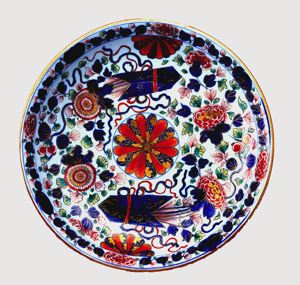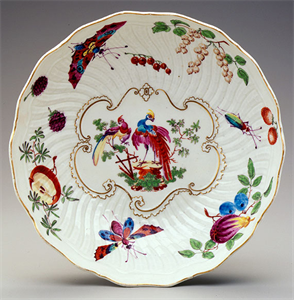
Chinese Export
This dish features the Chinese Imari palette of underglaze blue, iron-red, and gold with the addition of green. The name Imari comes from a town in the northern part of the Kyushu province of Japan. During the late seventeenth and early eighteenth centuries, the Chinese began to imitate Japanese Imari ware, and these new articles became known as Chinese Imari. They were made in quantity for the European market. In addition to the floral decorations of chrysanthemums and peonies, this dish is decorated with two colorful rockets with flaming tails. Fireworks were invented in China in the twelfth century as an adjunct to the invention of gunpowder, and were first used as a device for scaring away evil spirits.
Chinese Imari (Famille Verte) Dish
about 1710
Object Type:
Ceramic
Creation Place:
Asian, Chinese
Dimensions:
2 3/8 in. x Diam: 14 1/4 in. (6.03 cm x 36.2 cm)
Medium and Support:
Porcelain
Accession Number:
1998.0006.0001
Credit Line:
Gift of the Estate of William Francis McCall, Jr., by exchange
Currently On View
This dish features the Chinese Imari palette of underglaze blue, iron-red, and gold with the addition of green. The name Imari comes from a town in the northern part of the Kyushu province of Japan. During the late seventeenth and early eighteenth centuries, the Chinese began to imitate Japanese Imari ware, and these new articles became known as Chinese Imari. They were made in quantity for the European market. In addition to the floral decorations of chrysanthemums and peonies, this dish is decorated with two colorful rockets with flaming tails. Fireworks were invented in China in the twelfth century as an adjunct to the invention of gunpowder, and were first used as a device for scaring away evil spirits.
Keywords
Click a term to view the records with the same keyword
Portfolio List
Click a portfolio name to view all the objects in that portfolio
This object is a member of the following portfolios:
Your current search criteria is: Keyword is "EN" and [Object]Display Artist is "Chinese Export" and [Object]Century is "Eighteenth century".

 by Country (2)
by Country (2)
